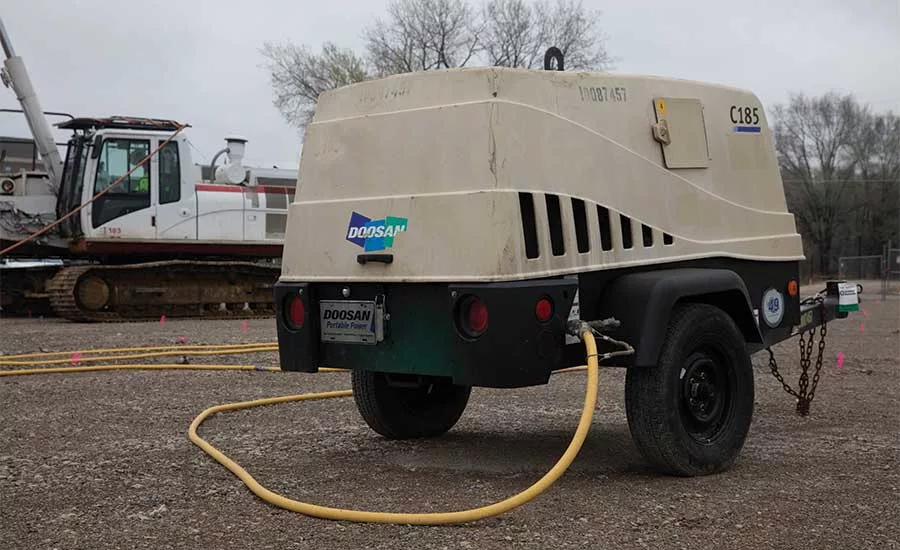When to Replace Air Compressors on Drilling Jobs

Proper maintenance prolongs equipment life, but there are options when compressors get up there in service hours.
Source: Doosan Portable Power
Whether you own a portable air compressor or an OEM drill with a built-in air compressor, you want the most out of your equipment including longevity, reliability, performance and productivity. However, with use, all equipment experiences wear and tear, which eventually affects the machine’s ability to meet expectations. So how do contractors get the most from an air compressor, and what are the options when an aging air compressor reaches the end of its lifecycle?
Proper Maintenance
Proper maintenance is key to making any piece of equipment last longer. Well-maintained equipment performs more efficiently, helps control service costs and ensures the safety of workers on a jobsite.
Proper maintenance includes following manufacturer recommendations for service intervals and using factory or OEM parts, filters and fluids. Routine maintenance intervals are usually based on hours of use, but daily, weekly and monthly maintenance checks should also be conducted. This includes a visual check of air compressor components such as fluid levels, wiring and hose connections, air inlets and parts that may be susceptible to wear. A simple two-minute inspection could save hours of downtime to replace a minor part. For instance, a cracked fan drive belt is an indication of excessive wear and an opportunity for proactive replacement before a shredded belt causes a machine shutdown.
One of the best ways to ensure the lifecycle of an air compressor is to use genuine manufacturer aftermarket parts that have been tested during the development of the machine. Using off-brand filters and fluids introduces unknown variables that could affect machine performance and equipment warranty packages.
Signs of Potential Issues
Following thousands of hours of operation, an air compressor may start to show signs of aging. Over time, bearings, rings and seals begin to wear, and machine performance can decline. Worn parts can prevent an air compressor from producing the desired pressure and flow necessary to perform an application, such as drilling or blasting.
Other signs of trouble include excessive machine vibration, extreme airend operating temperatures and metal deposits detected in an oil analysis. Most air compressors are equipped with a monitoring system that will alert the operator to excessive heat and, in some cases, shut the machine down automatically as a safety feature. If a warning or shutdown occurs, the airend should be checked for adequate lubrication and that the compressor oil is properly flowing through the oil cooler.
Other indicators that an air compressor is nearing the end of its lifecycle are cosmetic, such as rusted exterior sheet metal or broken reflector lights.
When an air compressor has reached the end of its lifecycle, there are a variety of options for replacing the unit. Purchasing a used or new air compressor is the best way to ensure high performance, along with having the newest technology and features in the machine. It is also the most costly option and may require purchase of a higher-tier engine. Price conscious machine owners who may wish to operate a lower-tier machine, such as a Tier 3, may prefer one of the following alternatives to replacing an aging air compressor with a newer model.
Alternatives to Replacing Aging Air Compressors
Contractors can consider these options when an air compressor starts to show its age.
Airend rebuild kit: An airend rebuild kit is an option for air compressors experiencing a decline in air pressure and flow, but which are otherwise in solid condition. An airend rebuild kit typically includes all the bearings, seals and O-rings found in an airend. A full rebuild is a very technical process. Much like an automobile engine or transmission rebuild, to successfully rebuild an airend, the person doing the rebuild should be trained and experienced in the work being performed.
Airend rebuild service: Because airends are complex pieces of machinery, many air compressor manufacturers offer an airend rebuild program with highly trained technicians. Remanufactured airends are carefully disassembled and inspected to ensure any damaged or obsolete parts are replaced. Each one is rebuilt by experienced craftsmen and may be eligible for a special warranty option. For example, the Doosan airend exchange program offers a factory-rebuilt airend that comes with a factory warranty and optional extended warranty.
Remanufacturing program: For air compressors that need a complete overhaul of internal and external components, remanufacturing is an alternative to replacement. The Doosan Remanufacturing program, for example, returns to the driller a remanufactured engine of the same tier classification as originally equipped, as well as a factory-reconditioned airend. The base frame and separator tank also receive a total makeover.
External components, including sheet metal, doors and lights, as well as internal components like coolers, sensors, hoses and piping, are replaced. Brakes and wheel bearings are replaced, a new wiring harness is installed, new fluids are added and filters are replaced. Some remanufactured machines can also be retrofitted with factory-installed options. All Doosan remanufactured air compressors are factory tested to ensure proper operation before shipment, and remanufactured air compressors typically come with a same-as-new warranty.
Looking for a reprint of this article?
From high-res PDFs to custom plaques, order your copy today!





